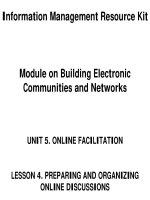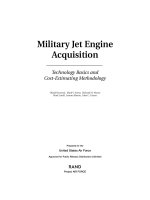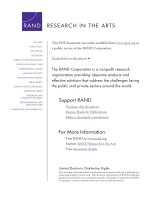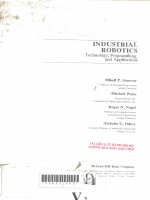online communication linking technology identity and culture
Bạn đang xem bản rút gọn của tài liệu. Xem và tải ngay bản đầy đủ của tài liệu tại đây (17.55 MB, 265 trang )
TeAM
YYePG
Digitally signed by TeAM YYePG
DN: cn=TeAM YYePG, c=US,
o=TeAM YYePG, ou=TeAM
YYePG, email=
Reason: I attest to the accuracy
and integrity of this document
Date: 2005.05.25 06:38:37 +08'00'
Online Communication
Linking
Technology,
Identity,
and
Culture
LEA'S
COMMUNICATION
SERIES
Jennings
Bryant
/
Dolf
Zillmann,
General
Editors
Selected titles
in the
series include:
Bucy/Newhagen
•
Media Access: Social
and
Psychological Dimensions
of
New
Technology
Use
Braman
•
Biotechnology
and
Communication:
The
Meta-Technologies
of
Information
Greene
•
Message Production: Advances
in
Communication Theory
Riffe/Lacy/Fico
•
Analyzing Media Messages: Using Quantitative Content
Analysis
in
Research
Wicks
•
Understanding Audiences: Learning
to Use the
Media Constructively
For
a
complete list
of
titles
in
LEA's
Communication Series, please contact
Lawrence
Erlbaum Associates, Publishers,
at
www.erlbaum.com.
Online
Communication
Linking Technology,
Identity,
and
Culture
Second
Edition
Andrew
F.
Wood
San
Jose
State University
Matthew
J.
Smith
Wittenberg
University
LAWRENCE ERLBAUM ASSOCIATES, PUBLISHERS
2005
Mahwah,
New
jersey
London
Senior
Acquisitions
Editor: Linda Bathgate
Assistant Editor: Karin Wittig
Bates
Textbook
Production Manager: Paul Smolenski
Full-Service Compositor: TechBooks
Text
and
Cover Printer: Hamilton Printing Company
This
book
was
typeset
in
10/12
pt.
Palatino Roman, Bold, Italic.
The
heads were typeset
in
Stone Sans, Bold, Italic,
and
Bold
Italic.
Cover design
by
Kathryn Houghtaling Lacey, based
on an
original design
by
Andrew Wood
Copyright
©
2005
by
Lawrence Erlbaum Associates, Inc.
All
rights
reserved.
No
part
of
this
book
may be
reproduced
in any
form,
by
photostat,
microform,
retrieval system,
or any
other means, without prior written permission
of the
publisher.
Lawrence
Erlbaum Associates, Inc., Publishers
10
Industrial Avenue
Mahwah,
NJ
07430
www.erlbaum.com
Library
of
Congress Cataloging-in-Publication Data
Wood,
Andrew
F.
Online communication
:
linking technology, identity,
and
culture
/
Andrew
F.
Wood,
Matthew
J.
Smith.
- 2nd ed.
p.
cm. -
(LEA's
communication series)
Includes bibliographical references
and
index.
ISBN
0-8058-4849-5 (pbk.: alk. paper)
1.
Information technology—Social aspects.
2.
Communication
and
technology.
3.
Communication—Social
aspects.
I.
Smith, Matthew
J.,
1971-
II.
Title III. Series.
HM851 .W66
2005
303.48'33—dc22
2004013812
Books
published
by
Lawrence Erlbaum Associates
are
printed
on
acid-free
paper,
and
their
bindings
are
chosen
for
strength
and
durability.
Printed
in the
United States
of
America
10
987654321
For
my
wife
and
daughter,
Jenny
and
Vienna,
my
family
in the
valley
and
over
the
hill
—ANDY
For my
family,
Susan,
Trevor,
and
Kent,
my
links
to
reality
—MATT
BRIEF CONTENTS
Part
I: The
Internet
as
Social
Technology
Chapter
1.
Using Technology
to
Communicate
in New
Ways
3
Chapter
2.
Understanding
How New
Communication Technologies
Work
29
Part
II: The
Self
Among
Others
Chapter
3.
Forming Online Identities
51
Chapter
4.
Relating Online
78
Chapter
5.
Seeking Therapy Online
101
Chapter
6.
Communicating
in
Virtual Communities
122
Part
HI:
Internet Culture
and
Critique
Chapter
7.
Rebuilding Corporations Online
147
Chapters. Accessing
the
Machine
166
Chapter
9.
Carving Alternative Spaces
179
Chapter
10. Pop
Culture
and
Online Expression
194
Appendix
A.
Introduction
to
Hypertext Markup Language
213
Appendix
B.
Researching
the
Internet Experience
222
vi
DETAILED
CONTENTS
Preface
xvii
Part
I: The
Internet
as
Social Technology
Chapter
1.
Using Technology
to
Communicate
in New
Ways
3
What
Is
CMC?
4
Why
Study CMC?
5
Immediacy
Versus Mediation
5
Mediated Society
6
Mediated
Self
6
Ethical
Inquiry
7
Mediated Reality
8
Hyperlink:
Technology
and
Tragedy
9
How Do We
Communicate Through CMC?
10
Electronic
10
Hyperlink: Chain Mail
and the
Proliferation
of
Internet Hoaxes
11
Bulletin Board
Systems
12
Internet Relay Chat
13
Multiuser Domains
14
The
World Wide
Web 15
Hyperlink:
Computer
Anxiety
16
Comprehending
the
Internet Through Language
17
Defining
Cyberspace
18
Finding
Cyberspace
19
Hyperlink:
Get a
(Real)
Life
20
Extending
the
Metaphor
20
Critiques
of the
Spatial Metaphor
22
Chapter Summary
23
vii
vili
DETAILED CONTENTS
Online
Communication
and the Law 23
Glossary
24
Topics
for
Discussion
25
References
26
Chapter
2.
Understanding
How New
Communication Technologies
Work
29
A
Brief
History
of
Cybernetic Technology
30
Thinking
Machines
in the
19th Century
30
Cybernetic Devices
in the
Early
20th Century
31
Ethical
Inquiry
33
Hyperlink: What's
the
Difference
Engine?
34
The
Internet
as
Cybernetic Organism
34
Hyperlink: Vannevar Bush
and His
Amazing Memex
35
What
Is the
Internet?
36
The
Browser
Wars
37
Hyperlink:
A
Post-Beige Revolution
38
What
Are
Some Characteristics
of
Online Communication?
40
Packet-Switching
41
Multimedia
41
Interactivity
41
Synchronicity
42
Hypertextuality
42
Hyperlink:
The
Dark
Side
of the
Rainbow
44
Chapter Summary
45
Online Communication
and the Law 46
Glossary
46
Topics
for
Discussion
47
References
47
Part
II: The
Self Among Others
Chapter
3.
Forming Online Identities
51
Hyperlink:
15
Megabytes
of
Fame
52
The
Principle
of
Telepresence:
Is
Anyone
Out
There?
54
Performing
Identity
on the
Internet
56
Casting Call: Performing Multiple Roles
58
Learning
One's
Lines: Performing Through Language
60
Gender-Swapping: Performing
in
Virtual Drag
61
Hyperlink:
The
Doggoned
Log-On
62
DETAILED CONTENTS
ix
Anonymity,
Pseudonymity,
and
Identity
63
Anonymity
63
Pseudonymity
64
Ethical
Inquiry
66
Hyperlink:
A
Rape
in
Cyberspace
67
Protecting Identities
in the
Information
Age 68
Identity Fraud
68
Shadow
Identities
70
Hyperlink: Judging Information
on the Web 71
Chapter Summary
72
Online
Communication
and the Law 73
Glossary
74
Topics
for
Discussion
74
References
75
Chapter
4.
Relating Online
78
Impersonal Communication: Defining Limits
to CMC 79
Social
Presence Theory
80
Social
Context Cues Theory
81
The
Impersonal Perspective Reconsidered
82
Hyperlink: Emoticons—Frequency
and
Force
83
Interpersonal Communication: Opening Channels Through
CMC 84
The
SIDE
Model
85
Frequency
of
Interpersonal Relationships
86
Hyperlink:
Task
and
Social Functions
of
E-Mail Among
Undergraduates
87
Hyperpersonal Communication: Transcending Relational Limits
through
CMC 88
Managing
Online
Relationships
90
Working
Relationships
91
Hyperlink: Matchmaker, Matchmaker, Make
Me a
Match
92
Romantic
Relationships
93
Ethical
Inquiry
95
Chapter Summary
95
Online Communication
and the Law 96
Glossary
97
Topics
for
Discussion
97
References
98
DETAILED
CONTENTS
Chapter
5.
Seeking Therapy Online
101
Internet
Addiction Disorder
102
Symptoms
of IAD 103
Hyperlink: Obscenity
in
Cyberspace
104
Addiction
to
Sexual Content
105
Ethical
Inquiry
107
Is IAD
Real?
107
Hyperlink: Computer-Assisted Therapy Programs
109
Online Therapy
110
Coming
to
Online Therapy
110
Communicating Support
in
Online Therapy
112
Hyperlink: Online Memorials
as
Therapeutic Communication
113
Shortfalls
in
Online Therapy
114
Chapter Summary
116
Online Communication
and the Law 116
Glossary
117
Topics
for
Discussion
117
References
118
Chapter
6.
Communicating
in
Virtual
Communities
122
Defining
Virtual Communities
123
Hyperlink: What
a
DivI'!
124
Precedents
for
Virtual Communities
125
Hyperlink: Society Comes
to
LambdaMOO
126
Qualities
of
Virtual Communities: What Makes
a
Community?
127
A
Minimum Level
of
Interactivity
128
A
Variety
of
Communicators
128
Common Public Space
129
A
Minimum Level
of
Sustained Membership
129
Qualities
of
Virtual Communities: What Attracts
People
to
Community?
129
External
Factors
130
Temporal
Structure
130
Infrastructure
of the
Computer System
130
Purposes
for
CMC's
Use 130
Characteristics
of the
Group
and Its
Members
131
Hyperlink: Commercialized Community
131
Netizenship: Responsibility
and
Regulation
in the
Virtual Community
133
Hyperlink: Group Decision Support Systems
136
Ethical
Inquiry
137
X
DETAILED
CONTENTS
xl
Critiques
of the
Community Metaphor
137
Chapter Summary
138
Online Communication
and the Law 139
Glossary
140
Topics
for
Discussion
141
References
142
Part
III: Internet Culture
and
Critique
Chapter
7.
Rebuilding Corporations Online
147
Hyperlink: Changing Corporation Cultures—Telephony
and the
Internet
149
CMC
as
Corporate Discipline
150
Ethical
Inquiry
152
Electronic
Surveillance
and
Anticipatory Conformity
152
Hyperlink: Microserfs
153
Corporations
and
Consumers Online
153
Cookies
154
Voluntary
Data Submission
154
Data
Mining
154
Ethical Inquiry
155
CMC
and the
Diffusion
of
Innovation
156
Communicating
New
Ideas
156
Communicating Through Channels
156
Communicating Over Time
156
Communicating
in a
Social System
157
CMC
and
Corporate Convergence
158
Convergence
and
Clusters
of
High-Tech Jobs
159
What
Are the
Factors Necessary
for the
Development
of
High-Tech
Clusters?
160
Chapter Summary
161
Online
Communication
and the Law 162
Glossary
162
Topics
for
Discussion
163
References
164
Chapter
8.
Accessing
the
Machine
166
A
Chicken
in
Every
Pot and an
Internet-Capable Computer
in
Every Home?
167
Race,
Class,
and
Internet Usage
168
Hyperlink:
The PEN and
Electronic Democracy
169
xii
DETAILED CONTENTS
Critiquing
the
Digital Divide
170
Snapshot Critique: Have-Nows
and
Have-Laters
170
Place,
Not
Race, Critique
170
Hyperlink: Mapping
the New
Economy
171
Rediscovering
the
"World"
in the
World Wide
Web 172
Ethical
Inquiry
173
Decentralization Versus Recentralization
173
Fragmentation Versus Integration
173
Diversity Versus Homogenization
174
Hyperlink:
The
Great Firewall
of
China
174
Chapter Summary
175
Online Communication
and the Law 175
Glossary
176
Topics
for
Discussion
176
References
177
Chapter
9.
Carving Alternative Spaces
179
Discursive Resistance:
Crafting
Alternative Spaces Within Dominant
Places
180
Places
of
Control: Spaces
of
Resistance
181
Hyperlink:
Laptops
in the
Jungle
183
Agonistic
and
Utopian Rhetoric Online
184
Ethical
Inquiry
184
Hyperlink: Kathy Daliberti's Cyber-Quilt
187
The
Rhetoric
of
Hate Online
187
Community
189
Anonymity
189
Outreach
189
Commerce
190
Information
190
Chapter Summary
190
Online
Communication
and the Law 191
Glossary
191
Topics
for
Discussion
192
References
192
Chapter
10. Pop
Culture
and
Online Expression
194
Literary
Depictions
of
Technology
195
The
Weakness
of
Human Flesh
199
The
Power
of the
Wired Corporation
200
The
Pace
of
Human
Life
201
DETAILED CONTENTS
xiii
Popular Film
and
Technology
202
Ethical Inquiry
202
2002:
A
Space
Odyssey—Confronting
Technology
202
Tron:
Taking
on the
Master Control Program
203
Hyperlink: "Invasion
of the
Dots"
204
WarGames:
Is It a
Game
or Is It
Real?
205
Blade
Runner:
More Human than Human
205
AI:
Artificial
Intelligence—His
Love
Is
Real.
But He Is Not 206
The
Matrix
Trilogy:
Ghosts
in the
Machine
206
Hyperlink: What About Virtual Reality?
207
Chapter Summary
208
Online
Communication
and the Law 209
Glossary
209
Topics
for
Discussion
210
References
210
Appendix
A.
Introduction
to
Hypertext Markup Language
213
Some Common Tags
216
Displaying Images
219
Other
IMG
Attributes
219
Uploading
and
Downloading Files
220
Appendix
B.
Researching
the
Internet Experience
222
Research into
the
Technical
or
Social Aspects
of CMC 222
Hyperlink: Reading
up on
Internet Research
223
Practicing Ethics
in
Online
Research
224
References
225
Glossary
227
Author Index
235
Subject
Index
240
PREFACE
When
someone says, "I'm going
online,"
where
are
they going?
Early
in the
21st cen-
tury,
when
so
much
of the
globe
is
mapped
and so
much geography charted,
is
there
really
a new
place
to be
visited
on the
World Wide
Web?
We
think
so.
Considering
online communication
as a
metaphorical journey involves adopting many
of the
same
words
and
images that
we use in
other excursions.
We
borrow ideas
from
our
physical
interactions
to
make sense
of
communication through computer networks. Using
the
Internet,
we
send
mail,
we
visit
libraries,
we
even
surf.
Yet
these
words
alone limit
our
understanding
of
online communication,
so we
must employ
new
ones.
Uploading,
downloading,
pinging,
networking—these
relatively
new
words hint
at a new
world
of
human interaction that emerged with
the
popularization
of the
Internet.
As you can
guess,
hundreds
of
books
promise
to
make
sense
of
this
new
world.
The
problem
is
that
most
of
these books
try to
explore online communication
as
merely
a
site
of new
tech-
nologies.
Few
attempt
the
synthesis
of
technology, identity,
and
culture that
we
feel
can
place
the
Internet
in
human perspective. This book
is our
attempt
to
fill
that void.
Online
Communication
aims
to
help
you
conceptualize
the
human uses
of the In-
ternet
by
examining
the
emerging theories that
offer
explanations
for
what people
are
doing with this technology, socially
and
communicatively. Now,
for
some
people,
theory
is a
dirty word.
It
suggests
lofty
and
vague treatises,
far
beyond
the
grasp
of the
average person. Theory, however,
has
gotten
a bad
rap. When explained with acces-
sible
language
and
concrete examples,
as we
have
tried
to do
here, theory
helps
us to
see how
processes tend
to
function
in a
variety
of
occurrences rather than
in
just
one
case.
The
value
to
using theory when approaching
the
Internet
is
this: Understanding
how
communication processes
function
in
general will allow
you to
apply them
to
recognizing specific instances
of
these
occurrences
in
your
own
life.
Over
the
last several years,
a
great deal
has
been written about
the
effects
of
com-
puters
on
human communication. Journalists have made
it the
focus
of
their human
interest stories, critics have cited
it as the
root cause
of
declines
in
society,
and
scholars
have examined
its
effects
on
everything
from
the way we
think
to the way we
relate
to
others.
In
order
to
establish some sense
of
coherence
in
addressing this body
of
information,
we
have organized this book into three general sections with
10
specif-
ically
themed chapters. What follows, then,
is a
brief
overview
of
those sections
and
chapters
and
other
key
features
you
will encounter
in
reading
Online
Communication.
Part I
of
this book includes two chapters that serve as introductions to both the tech-
nologies
of the
Internet
Age and
their social implications. Beginning with chapter
1,
we
introduce computer-mediated communication (CMC)
as a
subject
of
academic
re-
search
and a
fascinating
site where
we may
examine contemporary trends
in
society.
xiv
PREFACE
XV
We
examine
CMC as a
blurring
of two
types
of
interaction,
immediacy
and
media-
tion,
in
order
to
challenge
the
assumption that communication aided
by
computer
networks
is
necessarily less personal
and
less powerful than traditional modes
of
human discourse.
We
then
identify
the
technological
and
social
features
that distin-
guish
five
common
forms
of
CMC: electronic mail (e-mail), bulletin boards systems
(BBS),
Internet relay chat
(IRC),
multiuser domains
(MUDs),
and the
World
Wide
Web
(WWW).
We
conclude this chapter with
an
in-depth examination
of the
domi-
nant
metaphor used
in
conjunction
with
the
Internet,
cyberspace,
and we
consider
the
origins
and
implications
of
this
frequently
invoked term.
In
chapter
2, we
focus
our
attention
further
on the
technology
of
online commu-
nication,
including
a
brief
history
of
network computer technology
as a
social
force.
Starting with 19th-century
thinking
machines,
we
cover
the
modern
evolution
of cy-
bernetic
devices that
influence
our
interaction with people
and the
environment.
We
provide
specific
insight
on the
Internet's evolution
from
a
military command
and
con-
trol network
to the Web as a
kind
of
cybernetic organism.
We
then address
the
essential
characteristics
that distinguish
the
Internet
from
other interpersonal
and
mass com-
munication
contexts
by
reviewing
five
key
features setting
it
apart: packet-switching,
multimedia, interactivity, synchronicity,
and
hypertextuality.
Part
II of the
book
considers
issues
of
online
identity, taking into account
how
people construct presentations
of
self
within
a
social environment.
We
begin with
the
construction
of
online identity
in
chapter
3.
This chapter opens with
a
discussion
of
the
phenomenon
of
telepresence,
that
is, the
degree
of
realism
one
perceives through
a
given medium.
We
then turn
to the
role
of
theatrical metaphors
in
several scholarly
studies
of
Internet usage
and
explain
how
qualities
of
role-taking
and
play
are
evident
in
online interactions.
We
also examine
the
degree
to
which online identities
can be
anonymous,
and we
raise
warnings
that
the
Information
Age
presents
dangers
to
one's
individual identity, online
and in
real
life,
in the
forms
of
shadow identities
and
identity
fraud,
respectively.
Because
personal identity
affects
interpersonal communication,
we
turn
to
ques-
tions
of
establishing online relationships
in
chapter
4.
Scholarly arguments contend
that
there
are
three distinct perspectives here:
One
asserts that
CMC
fosters
an
imper-
sonal environment that
is
hostile
to
relationships; another says that
CMC can
sustain
interpersonal
relationships
that
are
comparable
to
those
negotiated
face
to
face;
and
yet
another suggests that
CMC
presents
a
hyperpersonal context
in
which people
uncomfortable
or
unsuccessful
in
other contexts
can
excel
at
relating.
In
addition
to
a
variety
of
theories associated with each
of
these perspectives,
we
also deal with
relationship
issues
such
as the
online conflicts known
as
flame
wars
and
infidelity
in
the
form
of
cyberaffairs.
Our
consideration
of
identity continues
in
chapter
5,
where
we
consider
how
people
address their
own
well-being through computer-mediated channels. Herein,
we
con-
sider
the
controversial concept
of
Internet Addiction Disorder, presenting
the
cases
for
and
against
the
existence
of
this communication-based problem.
Thereafter,
we
also
discuss ways
in
which people seek
the aid of
others
in
various
forms
of
online ther-
apy,
such
as
virtual
support
groups.
Accordingly,
we
review
the
types
of
messages
that
people typically exchange
in
these venues
and
pause
to
consider
the
possible
shortfalls
of
these mediated dialogues
as
well.
The
last chapter
in
this section
on
creating
the
self
among others, chapter
6, re-
flects
on the
growth
of the
social aggregate
itself,
the
so-called virtual community.
We
examine
several historical precedents
for
today's virtual communities, including
the
XVl
PREFACE
imagined communities created
by the
mass media
and fan
communities.
We
define
the
virtual community
in
terms
of
essential qualities
and its
attraction
to
participants
and
examine what standards
and
sanctions
are in
place
to
regulate
the
social behavior
of
good Internet citizens,
or
netizens.
Our
third
and final
section, Part III, addresses issues
of how the
Internet
has af-
fected
our
culture
and how
people
have responded
to
those changes with critiques.
For
example,
in
chapter
7, we
turn
to the
corporate side
of
online communication
and
its
impact
on the
information economy.
Initially,
we
focus
on the use of
computer net-
works
to
enforce
corporate discipline.
We
then turn
our
attention
to
methods
in
which
corporations
employ
online
communication
to
survey
and
influence
the
behaviors
of
consumers with techniques such
as
"cookies,"
voluntary data submission,
and
data
mining. Along with discipline,
we
study
the
diffusion
of
innovation through computer
technology
in
corporate environments, paying particular attention
to the
roles
of
inter-
action
and
diversity
as
factors
that influence
the
pace
of
computer-mediated change
at
work. Finally,
we
evaluate
the
trend
of
corporate convergence
and the
creation
of
megamedia
whose
embrace
of
online communication promises
to
change fundamen-
tally
the
ways
in
which
we
entertain
and
educate ourselves.
We
conclude this chapter
with
a
discussion
of the
rise,
fall,
and
potential rebirth
of the
Internet economy.
Chapter
8
addresses another question
of
culture
shift,
and the
critiques that accom-
pany
it,
when
it
examines
the
question
of
whether
a
digital divide exists beyond
the
media hype.
We
examine this divide along demographic dimensions such
as
gender,
race,
and
class.
We
then turn
to
governmental
and
community-based
efforts
to
close
the
digital divide
before
exploring recent critiques
of the
digital divide
as an
artificial
problem that obscures more
significant
concerns.
We
conclude with
a
reminder that
the
theorized
gap
between
information
haves
and
have-nots
may be
debatable
in the
United States,
but
this divide
is
undeniable around
the
world.
Chapter
9
offers
a
response
to the
argument that online communication merely
provides another site where
the
same
old
powers-that-be exercise control over
our
lives.
To
explore
this
possibility,
we
discuss
the
notion
of
discursive resistance through
which
individuals
and
groups employ online communication
to
critique economic
and
social systems while proposing
new
ones. This notion challenges
us to
theorize
cyberspace
as a
site
to
challenge dominant
places
of
power. Although
we
offer
case
studies
of
ways
in
which online communication provides disenfranchised
folks
a
chance
to
gain
a
voice
in
public
life,
we
also note
the
rise
of
Web-based hate groups
that employ
the
same freedoms
for
more insidious goals.
Chapter
10
concludes
the
volume with
a
study
of the
ways
in
which popular culture
artifacts
such
as
books
and
films
attempt
to
make sense
of the
increasing role computer
technologies
play
in our
lives.
This
analysis
begins
with
the
"cyberpunk"
movement
and its
literary antecedents dating back
to
Mary
Shelley's
Frankenstein.
Studying
cy-
berpunk,
we
reveal consistently appearing themes
in
literary evaluations
of
computer
technology
including
fears
that human beings
may
become obsolete
in
comparison
with
the
machine.
Turning
to film, we see
similar trends
in
movies ranging
from
Lang's
(1926)
Metropolis
to the
Wachowski
brothers'
Matrix
trilogy. Although books
and films
may
not
represent
"high"
culture, they
do
manage
to
provide
powerful
insight into
the
ways
in
which
we
struggle
to
make sense
of
online communication.
In
addition
to the
contents
of the
chapters themselves, three special components
of
Online
Communication
merit special attention: These
fall
under
the
labels Hyperlink,
Ethical
Inquiry,
and
Online Communication
and the
Law. Throughout this text,
you
will
find
material that
has
been
set
apart
from
the
text
in a
stylized
box and
labeled
PREFACE
xvii
a
Hyperlink.
If you are
familiar
with
the
Web, then
you
know that
a
hyperlink
is a
specially marked symbol
(in the
form
of
either words
or
images
on the
computer
screen)
that when clicked with
a
mouse will "jump"
to
another site
on the
Web.
Clicking
a
hyperlink
is
like
following
a
tangent,
a
line
of
thought that
is
related
to
but
somewhat
"off
course"
from
the
direction
of a
conversation.
As you
will see,
our
Hyperlinks perform
a
similar
function
in
that they present
information
and
indicate
topics related
to but not
explored
in as
much depth
as
those themes addressed
in
each
chapter. However,
we
hope that
the
insights presented
in
these asides will serve
as
bases
for
discussion
in
your classroom, around your dinner table,
in a
chat room,
and
wherever else
you
might
find
your
own
conversations
"jumping,"
as it
were,
to
online
communication.
Along
with Hyperlinks, boxes also
set
off
an
Ethical
Inquiry
in
each chapter.
Re-
viewers
of the first
edition
of
Online
Communication
asked
for
even more consideration
of
how
people
are
using their communication tools
and
talents
in
responsible
and
respectful
manners.
In
response,
we
offer
questions about
the
nature
of
human com-
munication conduct online. Rather than prescribe codes
for
ethical conduct
per se, we
hope that these interludes serve
to
spark discussion, within
the
reader, among class-
mates,
or
even involving people
not
reading this
text.
Our aim is to
prompt discussion
about
the
ethical challenges
people
face
as
they originate their
new
communication
behaviors
and
translate some
of
their
old
communication behaviors into
the
online
environment.
Our
hope
is to
spur readers
on to
reconsider,
if not
reaffirm,
their posi-
tions
as
ethical communicators
by
weighing
the
choices
and
consequences
they
may
well
face,
such
as
those
in the
brief
queries presented here.
Additionally,
we
have placed
a
section entitled Online Communication
and the
Law
at the
conclusion
of
each chapter. Although
this
book
is not
geared
for
prelaw
students,
we
have
found
that
our
attempt
to
provide
a
synthesis
of
technology, identity,
and
culture demanded some attention
to the
legal
ramifications
of the
issues raised
in
this
text.
The
belief
by
many Internet advocates that "information wants
to be
free"—
illustrated
by the fierce
debate inspired
by the
Napster case—has
met fierce
response
by
artists seeking
to
protect their labor, corporations seeking
to
protect their
profits,
and
parents
seeking
to
protect their
children.
Similarly,
the
belief
of
many Internet
observers that this medium should
be
regulated
and
taxed raises troubling questions:
Who
has the
authority
to
monitor online content
and
seek revenue
from
Internet-based
sales?
The
city,
the
state,
the
nation,
or
some
other
entity? Given that
the
Internet
is not
"based"
in any
locality,
it is
hard
to
imagine where
it may be
defined
as a
legal entity.
These
are
good times
to be an
Internet lawyer! Thus,
we
tackle thorny legal
issues
that
emerge
from
our
chapters'
topics such
as
one's
right
to
"flame" other Internet
users
to
recent
efforts
by the
recording industry
to flame
peer-to-peer music sharers.
If any
of
these topics seem entirely
new to
you,
don't
worry. They won't
be for
long. Ideally,
the
introduction
of
these
special sections—Hyperlinks, Ethical
Inquiries,
and
Online
Communication
and the
Law—will provoke some stimulating conversations among
your colleagues.
ACKNOWLEDGMENTS
In
getting
to the
point where
we
could share
our
perspective
of
this material,
we had
considerable help along
the
way.
We
would like
to
thank
our
respective universities,
San
Jose
State University
and
Wittenberg University,
as
well
as our
colleagues
at
xviii
PREFACE
each
institution
for
their
support
while
we
were
drafting
this text. Second,
we are
grateful
to
several anonymous reviewers
and
colleagues teaching computer-mediated
communication around
the
United States whose insights helped
us to
refine
our
prose.
Third,
we owe our
gratitude
to our
editor, Linda Bathgate,
and the
staff
of
Lawrence
Erlbaum
Associates
for
their
confidence
in
this
project.
Fourth,
we
express
our ap-
preciation
to
Joanne Bowser
and her
team
of
professionals
at
TechBooks
for
their
superb editing skills.
Fifth,
we
want
to
acknowledge
the
faculty
of our
alma mater,
Ohio University,
who
helped encourage
our
scholarly
efforts
by
guiding, challenging,
and
mentoring
us
through many intellectual,
personal,
and
professional obstacles.
Finally,
we
thank
our
students
who
offered
critical
advice
to
draft
versions
of
this
book.
Our
students
guide
us and
inspire
us to try
great things.
We
hope this volume
does
the
same
for
them.
—Andy
and
Matt
PART
•
THE
INTERNET
AS
SOCIAL
TECHNOLOGY
The
growing impact that
the
Internet
has on our
lives
is
increasingly
difficult
to
ignore.
Even
those
who
might claim
to be
"computer illiterate"
are
likely
to
encounter
the
direct
or
indirect
effects
that
the
Internet
has had on the
society
in
which
we
live.
For
example, pick
up The
Wall
Street
Journal
and you are
likely
to see
that
the
stock market
has
risen
or
fallen
in
correspondence with
the
successes
and
failures
of
Internet-based
companies.
Begin
a
term
project
by
doing some research,
and you are
likely
to find
that
the
campus library
has all but
abandoned card catalogs
in
favor
of a
quicker, more
space-efficient
electronic system,
one
that
is
probably accessible
from
your dorm room
or
home.
Turn
to
your classmates
and ask if
they
or
someone they know
has
ever made
friends
or had a
date with someone they
met
online,
and
they will probably cite
an
acquaintance
or
two. Without having
to
look much farther
than
the
world around
you,
you are
likely
to find the
ever-increasing influence
of the
Internet
in the
realms
of
economics, academics,
and
personal relationships, among many others.
Despite
its
pervasiveness
in our
lives, however,
how
well
do you
really understand
the
Internet? Here,
we are not
asking about your knowledge
of the
programming lan-
guages
and
hardware configurations that make
the
Internet
function.
Our
colleagues
in
computer science best explain those technical matters. Rather,
we are
asking about
your understanding
of the
human uses (and misuses)
of
that technology
in
social
terms. This
first
part
of the
book provides some
insights
for
addressing this ques-
tion.
In the
next
two
chapters,
you
will read about
the
social character
of the
Internet,
that
is, how
people have conceptualized
and
used
the
various Internet technologies
in
accord with
or in
consideration
of one
another.
The
communicative, historical,
and
linguistic concepts that
we
introduce
in
this part
of the
book
form
a
foundation
for
the
discussions
we
build
on in
subsequent
chapters.
Furthermore, they
testify
to
the
growing breadth
and
depth
of the
technology's
effects
on
human thought
and
action.
1
This page intentionally left blank
CHAPTER
1
USING TECHNOLOGY
TO
COMMUNICATE
IN NEW
WAYS
The
Internet
is
like
a
giant
jellyfish.
You
can't
step
on it. You
can't
go
around
it.
You've
got to get
through
it.
—John
Evans
At
the
heart
of
this book rests
a
basic assumption: Communicating
in
computer-
mediated contexts
is
somehow
different
than
any
other
form
of
communication.
Soft-
ware
engineer
Ellen Ullman (1996)
describes
encounters
in
which
these
differences
have been made apparent
to
her.
She
regularly communicates with
her
fellow
com-
puter programmers
and her
supervisors through
her
computer. Over
the
years,
she
has
reportedly acclimated
to the
shortness
and
arrogance that many
of her
colleagues
seem
to
convey
in
their correspondence. Such behavior
is, of
course,
not
restricted
to
online interaction. However, what
has
struck Ullman more
are the
contrasts
she
has
noted between mediated
and
face-to-face
interactions with
her
coworkers.
Two
examples illustrate Ullman's keen perceptions.
On
one
occasion, Ullman (1996) found herself
up one
night
and
decided
to
send
a
message
to a
colleague.
He
happened
to be
awake
as
well and,
after
reading
her
message, wrote back
to
inquire
why she was up so
late.
The two
exchanged cordial
messages that night,
yet the
next
day
when they attended
a
corporate meeting
to-
gether, Ullman
was
unsure about
how to
approach him. They had,
after
all, been
friendly
with
one
another
just
hours
before,
yet in the
office
setting,
she
questioned,
"In
what
way am I
permitted
to
know
him?
And
which
set of us is the
more real:
the
sleepless ones online,
or
these bodies
in the
daylight?"
(p. 6).
On
another occasion, Ullman
(1996)
had
struck
up a
romantic relationship with
a
fellow
programmer.
For
quite
a
while,
the two
communicated exclusively through
exchanges
of
electronic mail
(e-mail).
He
would send
her a
message,
she
would reply,
and so
forth.
This continued with increasing
frequency,
until they were writing
to one
another almost every waking hour. Eventually,
the
couple decided
to
meet
for
dinner,
and
when they did, Ullman noticed something unusual about their conversation. "One
talks, stops; then
the
other replies, stops.
An
hour later,
we are
still
in
this rhythm. With
a
shock,
I
realize that
we
have
finally
gone
out to
dinner only
to
exchange
e-mail"
(p.
17).
The
questions
and
patterns that Ullman developed
as a
practitioner
of
computer-
mediated communication (CMC)
did not
fully
emerge until
she saw the
assumptions
of
one
form
of
interaction contrasted with another. What
she had
learned
to
accept
as
norms
in the
world
of
computer mediation seemed
odd and
uncomfortable
to her in
3
4
CHAPTER
1
real
life.
Some people report
a
similar
feeling
of
dissonance when working
in
just
the
opposite manner, coming
from
the
familiar
practices
of
face-to-face
interaction
to the
subtle distinctions associated with CMC. Either way, people like Ullman,
and
perhaps
you,
are
aware that some
things
about
the
online experience
are
different.
In
this chapter,
we
examine
CMC to
understand
the
experience
of
online interaction.
Naturally,
this requires
an
overview
of
just
what
CMC is and how it
fits
within
the field
of
communication studies
and
popular culture. Following this discussion,
we
examine
CMC
as a
blurring between immediate
and
mediated communication.
As
shown
here, this process
of
blurring holds important implications
for our
conceptions
of
self
and
society.
The
question remains, however:
How do we
communicate
differently
in
this medium than through other traditional modes
of
interaction? Answering that,
we
explore popular components
of
online communication, including e-mail, bulletin
board systems
(BBSs),
internet relay chat
(IRC),
multiuser domains
(MUDs),
and the
World
Wide
Web
(WWW).
The
third
major
section
of
this
chapter introduces
the
study
of
cyberspace
as a
metaphoric means
to
understanding CMC.
To
that end,
we
explore
the
meaning
of the
word
cyberspace
and the
location
of the
cyberspace experience
before
extending
our
study
to the
alternative metaphors
for our
online interactions.
We
conclude with
a
reminder that dominant spatial metaphors
for CMC may
limit
our
understanding
of
this environment.
WHAT
IS
CMC?
In
this section,
we
begin
to
explore
computer-mediated
communication (CMC)
as an
integration
of
computer technology with
our
everyday lives.
The
field
of CMC
studies
how
human behaviors
are
maintained
or
altered
by
exchange
of
information through
machines.
How do we
study this process?
By
pulling
on the
insights
of a
variety
of
researchers
and
commentators.
In
communication
studies,
most scholars avoid
setting
up
disciplinary boundaries
so
rigid that
we
miss
out on
fascinating
human
phenomena simply because they
don't
"fit"
artificial
boundaries.
We do not
want
to
neglect
the
contributions that allied
fields
like psychology, sociology,
and
composition
studies
(to
name
but a
few) have
to
offer.
Even within
an
area
of
research
as
specific
as
CMC,
we
must
not
lose sight
of how
this mode
of
human interaction
affects
so
many parts
of our
lives
as to be
almost ever present. Nonetheless,
it is all too
easy
for
us to
blur
the
distinction between
our
chosen
focus
of
study
and the
larger
forces
of
technology shaping
our
lives. Doing
so, we
risk making this
text
an
unmanageable
mess.
For the
sake
of
simplicity, therefore,
we
propose that
our
study
is
limited
to the
analysis
of
those technologies that serve more
or
less directly
to
mediate intentional
human communication.
Here's
an
example: Although nuclear power plants—each with many computer
processors
and
terminals—remain
a
significant
component
of the
U.S. energy system,
these sites would
not
play
a
significant
role
in the
study
of
CMC.
We
talk about nuclear
power plants—their potentials
and
their threats—but
we
seldom
talk
through them.
The
presence
of
computer technology, therefore, does
not
constitute
the
only required
component
for our
analysis.
We
choose, instead,
to
focus
on
those technologies that
help individuals
and
groups relate
to one
another
in
some fashion,
for
good
or for
ill.
As
you
might
guess,
the
primary focus
of our
work
is the
Internet—that network
of
networks. Although
we
learn more about
the
Internet later
in
this chapter,
it is
important
at
this point
to
know
a key
distinction
we
make between
the
chips
and
COMMUNICATING
IN NEW
WAYS
channels that comprise this medium. Although
the
architecture
of
computer devices
that
aid the
transmission
of
digitized information around
the
world
is
itself
a
fascinat-
ing
topic, such
an
inquiry
is
beyond
the
scope
of
this book.
Rather,
we
have chosen
to
focus
on the
channels
of
communication made possible
by the
Internet,
on
what
has
been
called
the
"space
within
[the]
lines"
where human
beings
exert
individual
will,
conduct
business,
and
form
communities.
In
this way,
the
emergence
of
telephony
in
the
19th century
is
quite analogous
to our
study
of
contemporary computer technolo-
gies.
The
principle
of
mediated discourse—whether mainly
by way of
telephone
or
through
the
more sophisticated technologies
of
today's desktop computers—inspires
careful
examination because
of its
potential
to
alter human interaction without
the
need
for
physical presence.
WHY
STUDY CMC?
Certainly
the
student
of
communication
can find
plenty
of
other phenomena
to ex-
plore, such
as
small-group interaction, corporate culture building,
and
health
care
discourse. However,
we
focus
on CMC
because
of its
impact
on all of
those contexts.
Many
student
"study
teams"
find
online
chat rooms
to be
more
convenient
than
face-
to-face
interaction. Many corporate
offices
streamline internal communication with
e-mail.
Many
patients
use the Web to
inform
themselves about their medical
options.
In
each case,
the
introduction
of
online media changes day-to-day
life
and
alters,
to
some degree,
how we
relate
to
each other.
We
approach these topics with
a
desire
to
understand
the
blurring
of
technol-
ogy
with
our
everyday lives.
We
study
the
sophisticated ways
in
which computer
technology—the
microchips that process information
and
execute commands
and
the
software
that allows human beings
to
employ this technology—is integrated into
our
physical environments, interpersonal relationships,
and
even senses
of
personal
identity. Although technology
has
always played
a
role
in
social
life,
the
power
of
computer technology
offers
a new
dimension
to
this
theme.
Where
computing
de-
vices were once rare, expensive,
and so
complicated
as to
require expert attention
at
all
times,
the
computers
we use are
more subtly embedded
in our
lives.
Our
use of
telephones, cars, microwave
ovens,
and
even clothing increasingly requires
some
use of
computer technology. Thus, when
we
study CMC,
we
don't
just
explore
the use of
technology
in
communication;
we
study
the
blurring
of
technology with
our
everyday lives.
Thus far,
we
have identified
CMC as the
study
of how
human
behaviors
are
main-
tained
or
altered through exchange
of
information through machines,
and we
have
positioned
CMC
research within
the
realm
of
communication studies.
Our
next step
is to
examine
a key
component
of
communicating
online,
the
distinction between
im-
mediacy
and
mediation.
As we
discover, computer-mediated interaction increasingly
appears
to
blur
any
distinction between these terms.
IMMEDIACY
VERSUS
MEDIATION
Think
back
to
Ullman's
(1996)
narratives.
She
felt
tension regarding
a
colleague with
whom
she had
communicated
all
night through
the
Internet.
She
felt
connected, close
to her
coworker.
But
when they
met the
next day, neither
had a
framework
to
orient
5









